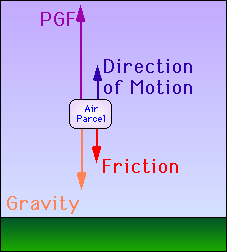
Gravity
Gravity is a force with which we are all familiar. It is the force that is produced by the earth and pulls all objects towards its center. Gravity causes an acceleration which is equal to the familiar 9.8 meters per second squared. This force is approximately the same magnitude as the vertical PGF, but points in the opposite direction and therefore produces a net force near zero. When gravity and the PGF perfectly balance each other, we call the situation hydrostatic equilibrium. We will discuss this later in the session.
Friction influences vertical motion just as it does horizontal motion. Friction works against motion. If a parcel is moving up, friction is directed downward, and vice versa. However, remember that parcels can reach a level where the frictional influence is approximately zero. This occurs in the free atmosphere above the friction layer. In the layer below the free atmosphere, friction plays a major role in air motion.





 The Shodor
Education Foundation, Inc.
The Shodor
Education Foundation, Inc.